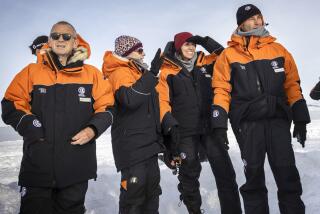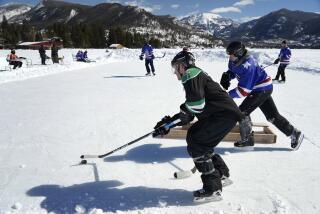Deeply Buried Antarctic Lake Holds Mysteries
- Share via
British researchers in Antarctica have mapped what may be the most unusual lake in the world--a body of unfrozen fresh water the size of Lake Ontario buried two-and-a-half miles beneath the ice of the coldest spot on Earth.
Researchers suspect the unsullied lake water may harbor an ancient trove of living bacteria, viruses and simple plants essentially unchanged for a million years. But they are unsure how to tap into the lake without contaminating its pristine waters or unleashing pent-up water pressure powerful enough to demolish a surface drilling station.
Located under a shield of ice so thick it crushes a continent under its weight, the lake is 124 miles long, averages 400 feet deep and is half again as large as scientists initially suspected, according to new research made public Wednesday. The lake lies directly below Russia’s Vostok research base in East Antarctica.
“The biologists are very interested because it might be that some very early life forms exist in the water,” said Vladimir Lipenkov, of the Russian Arctic and Antarctic State Research Center in St. Petersburg, who led this year’s Russian research expedition to the Vostok station.
“People are dreaming of this water,” he said.
The discovery of the buried lake beneath Vostok is all the more surprising because, at the surface, the plains of perpetual ice are so arid, due to the cold, that people can die of thirst almost as easily as they can freeze to death in what are officially the lowest natural temperatures to be recorded on the planet--128.6 degrees Fahrenheit below zero.
Scientists have suspected the existence of the lake for almost 20 years, based on cursory airborne radar studies of the surface conducted in the mid-1970s. Not until 1993 was there enough satellite data for researchers at the Scott Polar Research Institute at Cambridge University in England and the Russian Academy of Sciences to begin calculating its vast boundaries and chemical composition.
By coupling the satellite data with additional seismic studies and radio-echo sounding surveys, researchers have been able to calculate that the lake--named Lake Vostok--is the largest of what appear to be 70 lakes buried under East Antarctica and the biggest sub-glacial lake in the world “by an order of magnitude,” the scientists said in research published today in Nature.
The lake encompasses 5,400 square miles and contains about 433 cubic miles of unfrozen water. In some places, the water is more than 1,600 feet deep, the researchers said. Its temperature hovers near freezing, and the water may be kept fluid by a combination of pressure and geothermal warming.
The water itself may, on the average, be about 50,000 years old. But its life forms may be as much as a million years old and its lake bed sediments may be several million years older than that.
The researchers said the lake is “an exceptional environment that should provide useful information to the biological community and to geologists.”
Some experts suggested the possibility of discovering valuable antibiotics or industrial enzymes in the genes of bacteria that have survived in the lake, isolated from both regional and global changes.
Several U.S. officials, however, questioned whether the technology even exists to safely tap water buried so deeply under the ice. For the foreseeable future, the biggest beneficiary of any project focused on Lake Vostok, they said, would be the faltering Russian Antarctic program.
By a remarkable coincidence, Russian and French drillers are now poised above the lake, even though they had no idea it was there when they began exploring more than a decade ago.
The Russian program there is the most ambitious drilling program ever undertaken on the southernmost continent. An international team of scientists has been drilling deep ice cores there for the past decade to study climate change.
So far, the evidence of the Vostok core has been key in the debate over global warming. Indeed, it was ancient ice from Vostok that first established a conclusive link between amounts of carbon dioxide in the atmosphere and changes in Earth’s ancient climate.
By January, when drilling operations there were suspended, the researchers had drilled to within several hundred yards of the lake’s upper edge. But before undertaking any investigation of the lake itself, researchers are debating how best to proceed without contaminating the lake or destroying the bore hole.
In recent years, the Russian program has depended heavily on support from the United States to keep its research programs in Antarctica in operation. Once the current drilling program is completed, there may be no more international support for the Vostok station.
Scientists across Antarctica have tapped its ice sheets to reconstruct the chemistry of Earth’s ancient atmosphere and its changing climate. No one has drilled deeper and further into Earth’s past in Antarctica than the international team working at the Vostok Station.
This year, working in temperatures near 90 degrees below zero, they reached a depth containing sediments from 400,000 years ago, encompassing four ice ages. The cores also revealed a variety of microorganisms, ranging from yeasts and algae to microbes and spore-forming bacteria.
Then the drillers ran out of money. Earlier this year, Russian scientists simply shut down the Vostok station for the winter because of lack of funding. The 12 scientists there were flown to McMurdo, the main U.S. base in Antarctica.
It is not the first time Russian officials have temporarily closed Vostok and, in recent years, international support--especially aircraft and supplies donated by the United States--has been increasingly important.
Last year, for example, the Vostok station was resupplied by aircraft from American Antarctic bases when Russian resupply trains faltered.
Only last week, a U.S. National Science Foundation research vessel delivered four tons of emergency supplies to Russia’s Mirny station on the coast, where 38 people are spending the dark Antarctic winter, after a Russian supply ship developed mechanical problems.
The Mirny station is essential to the operation of Vostok and, if it must be closed, there is little prospect that Vostok will reopen any time soon, U.S. officials said Wednesday.
“With any luck--if we do have a field season at Vostok this summer--they will complete the drilling,” said Julie Palais, Antarctic Glaciology Program Manager for the National Science Foundation. “Then our work would be done.
“Unless they have another high-profile project to fill its place, it is likely our support for Vostok and the Russian program would certainly go down,” she said.






